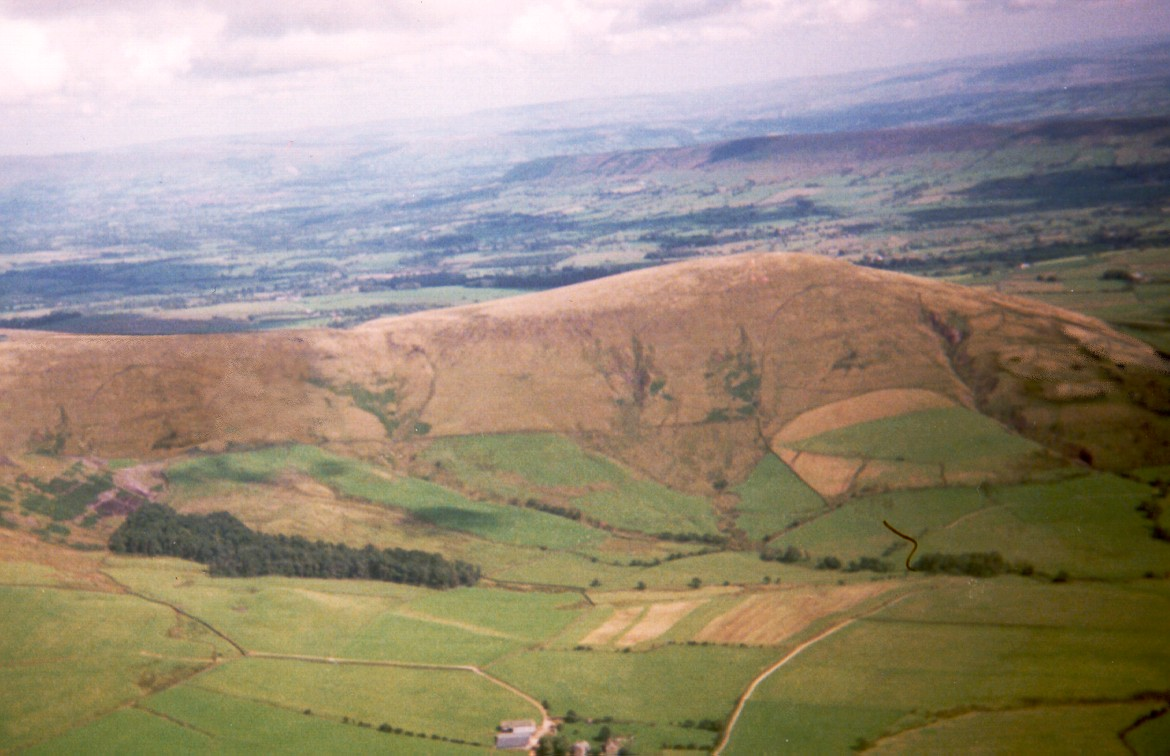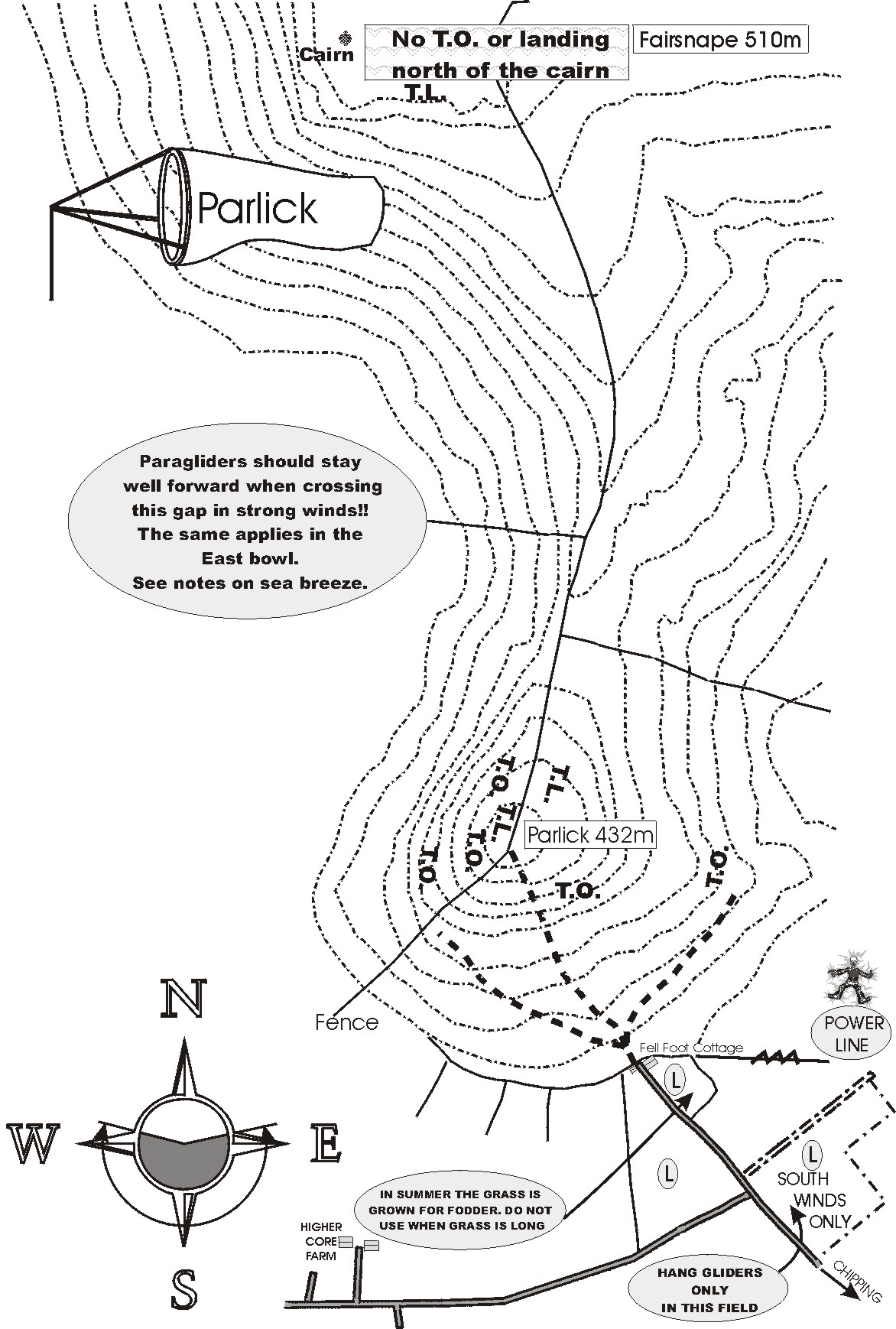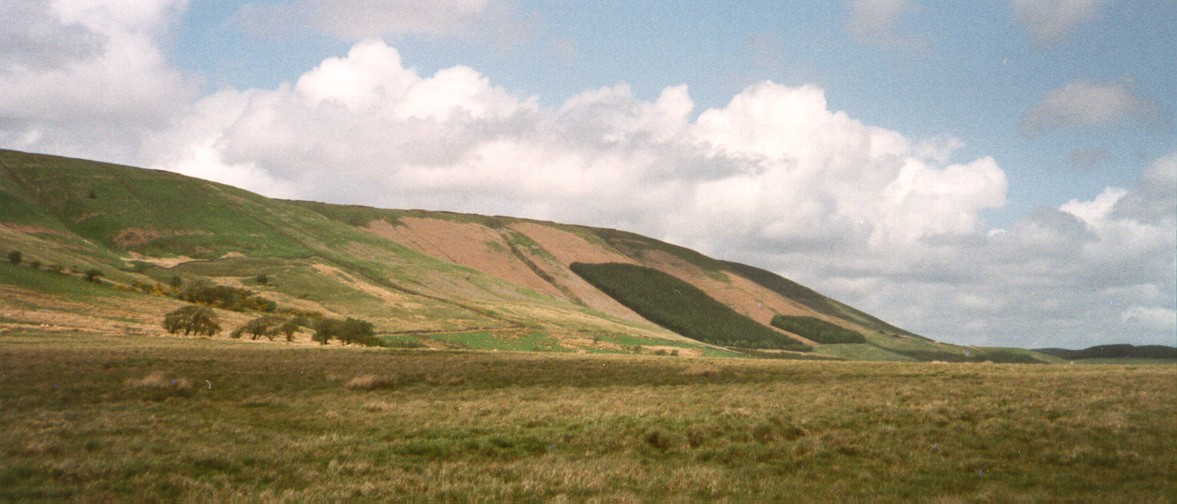Parlick
Site Notices
Do Not Fly without viewing the videos in the Safety section

| Wind Directions | WNW - ENE | OS Ref | SD 596 451 (Sheet 102) |
|---|---|---|---|
| Height ASL | 1417ft (432m) | Rating | CP |
| Top to Bottom | 630ft (192m) | Notam | m: 17.021 |
Directions
Follow the signs for Chipping from either Longridge or Clitheroe. In Chipping, turn North between the Church and café, keep left past the old chairworks, bare left at the fork junction by a farm, up a steep hill and turn right at the T junction. Keep straight on to Fell Foot.
Parking
Park on the lane below Fellfoot Cottage, please keep to the parking bays and do not obstruct the road. Please keep the gate to the landing field clear at all times as this is used for access by the farmer.
If the parking bays on the lane are full park on the Startifants Lane keeping your car as tight up to the fence/stone wall as possible.
Do not park too close to the entrance road to Wolfen Hall this restricts access and egress to Wolfen Hall
Access
Once parked walk up the road to Fell Foot Cottage and pass through the gate closing it behind you, then choose your path depending upon the wind direction.


Airspace
Keep below FL65. Dropping to FL55 above the East end of the Totridge run.
Safety
Note the power line near to the small landing field.
The airspace at Parlick is used by sailplanes, modellers, hang gliders and paragliders so consideration is needed. All pilots should view this video, made in conjunction with Bowland Forest Gliding Club, before flying here. https://youtu.be/tibDCFupGgo. This explains how the gliding club operates and provides valuable insights into how to fly safely in the mixed traffic that is a regular feature on Parlick.
In addition, the video we made for the gliding club about how paragliders operate is worth 10 minute of your time: https://youtu.be/SUK8olzXKSE.
We have shared this airspace amicably and safely for decades, let’s all do our bit to maintain the high standards of airmanship needed.
NB: see article - Flying with Sailplanes to view what we have published in the past.
Ask advice about the landing fields before you find out the hard way!
What to do if a power line is involved:
- Do not approach the casualty, the cable or anything in contact with it
- Even if the power appears to be off, it may become live again, several times
- If there is a phone number on an adjacent pylon/pole, phone it, or 999 to report
- WAIT for a human to inform you it is safe to approach
Notes
This is our most valuable site, and our use of it is high profile, so best behaviour always please. Leave all gates as you find them, don't climb walls and fences, no litter and keep dogs under control.
Current webcam image:
Parlick is actually three sites rolled into one. It has three distinct faces: East, West and South. The site is close to the sea and is effected by sea breeze, often very early in the afternoon on a good day.
When the sea breeze comes through it can result in short periods of very good lift on the West face, but when this has gone through it's very difficult to get away XC. On the other hand, the sea breeze can give easy and very pleasant ridge soaring on the West face on a summer’s evening, no matter what the general wind direction (so long as it's fairly light).
The site can be particularly good in a SSE wind when a ridge run of some 8 Km off to the
East is possible. This is known as ‘The Totridge Run’ (see picture below).
The sea breeze often causes a change of wind direction. So for example in an Easterly wind, pilots may be flying in the East bowl at lunch time. As the sea breeze comes in, it is not unknown for pilots to crab around the South face and end up flying in the West bowl.
In reasonable wind strengths take off is possible from as low as half way up in most wind directions. From the top, Southerly and Easterly take-off’s can be effected anywhere on the edge into wind. Westerly take offs are from the other side of the fence but please use the stile.
For bottom landings in a Westerly, either of the small rectangular or the large triangular fields to either side of the approach road may be used. Both of these fields slope to the South, so walk the landing area prior to flying and ask a local experienced pilot for guidance.


Paragliders
In the West bowl, always stay well forward of the ‘saddle’ in strong winds (particularly South West winds). The compression here has led to many pilots being blown back into the East bowl. The collection of small hillocks found at the North end of the East bowl has been the stage for many a white knuckle ride. Make sure that you go ‘over the back’ on a
thermal rather than just good ridge lift. This is good advice for any XC attempt.
Take care when landing in either of the two fields at fell foot in strong East and West winds. The compression around the South face cause wind speeds at ground level, which are not far short of those found at the top of the hill. Many a pilot has flown down from the bowl and turned back into wind only to find themselves going backwards. Never fly beyond your chosen landing field
Hang Gliders
Top landings on the South and East faces are relatively easy but the East face slopes, so hang gliders should land well back from the edge.
Top landing in an ESE wind: in 16mph+ winds do not attempt to float the glider in due to the turbulence at the top. It is essential to maintain flying speed in order to retain good roll authority and to be able to handle the gusts, this is absolutely essential for wind speeds of 25mph+. The air flowing up the E and SE face meeting at the top seems to be the cause of
this turbulence.
In a Southerly wind, hang gliders should use the field marked 'South wind only' as the other fields have too great a slope for safe landings. We do not have formal approval to use this field so DO NOT USE THIS FIELD FOR ANY OTHER WIND DIRECTION. The gamekeeper at Wolfen Hall can be hostile.
XC Potential
Excellent ridge runs and XC potential. From the West, many flights into Yorkshire have been made. Indeed as well as the record into Cumbria.
From the East, it is quite easy to reach the coast. Warn Blackpool ATC if you're likely to pass through their airspace. Whilst from the South face, flights to the Lake District have been recorded.
